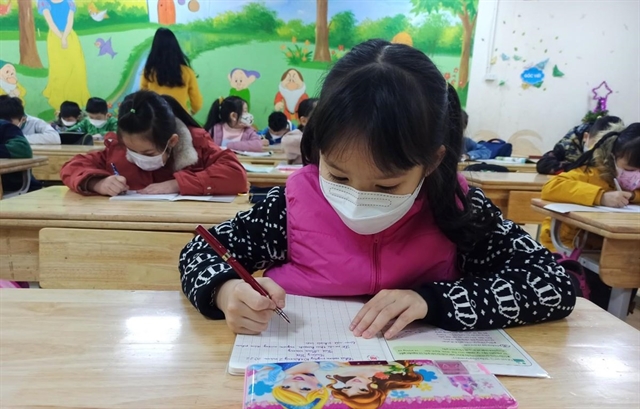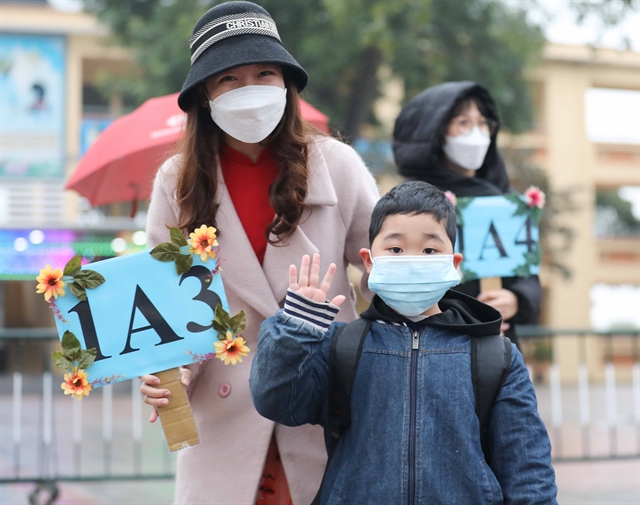 Society
Society

As children in Hà Nội finally return to school after a long time spent learning online, parents are filled with mixed emotions.

|
| Students at Phạm Tu Primary School, Thanh Trì District, Hà Nội on Thursday. —VNA/VNS Photo Phạm Mai |
HÀ NỘI — As children in Hà Nội finally return to school after a long time spent learning online, parents are filled with mixed emotions.
Nguyễn Hương Giang, a mother of a student in the capital's Long Biên District, said the feeling of joy when her child was allowed to return to school did not last long.
Just a day after the children were back in class, the teacher announced that two students tested positive for COVID-19, meaning it was back to online lessons.
Her child has been vaccinated, however, she still worries that he can get the virus from classmates and transmit it to family members, especially grandparents – who have underlying medical conditions, she said.
Trần Phương Thảo, of Nam Từ Liêm District, said before allowing students back to school, schools should ask families to do a quick test.
This would detect COVID-19 in the children and ensure safety for other students and teachers in the schools, she said.
Vũ Thị Loan, a mother of a third grader of Thanh Liệt Primary School, Thanh Trì District, said although she believes in the school’s COVID-19 pandemic prevention and control measures and the city’s policies, she still feels worried.
Đỗ Thị Ngà, a mother of two students at Thanh Liệt Primary School, said: “I have mixed feelings, both happy and concerned.”
Ngà has prepared masks, drinking water bottles and told her children to carefully avoid the spread of the SARS-CoV-2 virus.
Headaches when picking up children
Due to the pandemic, students are only allowed to have one class (in the morning or afternoon) each day instead of a full day as before.
Primary schools also do not provide lunch for the students.
This causes headaches for many parents when picking up and dropping off their children when they still have to go to work.
Ngà said she has two children, one attending school in the morning and another in the afternoon, so taking them to school and picking them up a total of four times a day affects the work of her and her husband.
Nguyễn Anh Tuấn, of Hoàn Kiếm District, said he and his wife have to take turns taking their son, who is a primary school student, to school, as well as preparing lunch.
It takes time and causes problems for Tuấn and his wife because they work far from home and the school, he said.
“We hope that the school will have a suitable solution to fix the problem soon,” he said.
Nguyễn Hồng Vân, of Đông Anh District, said she has two children, an eighth grader and a first grader.
When both of them learn online, the older brother could prepare lunch for the younger sister, she said.
Now, when both of them are back in school, Vân and her husband have to arrange time to take them to school and prepare lunch each day, she added.
“Our lives have been disturbed a little bit,” she said.
In the morning, Vân takes the younger daughter to school then she goes to work. At noon, she leaves the office to pick her daughter up before returning to work.
Her husband takes the older son to school, goes to work and picks the son up at noon. Vân prepares both breakfast and lunch for the two children early in the morning to save time, she said.

|
| A teacher of Đa Tốn Primary School welcomes a student back to the school on Thursday in Gia lâm District, Hà Nội. — VNA/VNS Photo Thanh Tùng |
Supporting measures
Trần Thị Thanh Huế, head of the Education and Training Office of Sóc Sơn District, said the office understood the difficulties faced by parents.
Huế said the office has told local schools in the district to arrange teachers to stay late in case parents are not able to pick their children up on time.
Minister of Education and Training Nguyễn Kim Sơn said according to the recommendations of medical experts, there is little benefit in splitting up classes in the morning and afternoon in terms of pandemic prevention.
Therefore, schools should consider helping both students and their parents when the students return to the schools if possible, he said.
The ministry told the localities to not neglect pandemic prevention and control measures, but also assist parents, he said.
It will affect the students' studies and activities, he said.
The schools are advised to monitor students' health to detect suspected cases, he said.
How to deal with COVID-19
The ministry has recently issued a safety handbook to instruct schools on how to deal with students who are infected with COVID-19 before allowing children back to school.
In the handbook, there are four steps to handle a student with COVID-19.
The first is that the school has to inform the Steering Committee for COVID-19 Pandemic Prevention and Control under the city’s Education and Training Department and the local health station to take prompt measures.
The second is to assess the health of the student, if he or she shows signs of respiratory failure, difficulty breathing and their peripheral oxygen saturation (SPO2) is below 97 per cent, the child should be taken to hospital.
If they have no symptoms or mild symptoms, parents should take the student home and follow instructions of the local health station to monitor and treat their child.
The third step is to immediately suspend the class to disinfect the classroom and test all students and teachers. Other classes will go ahead as normal.
The fourth step is quarantining students and teachers, who have been in direct contact with the COVID-19-positive student, at home following the instructions of the ministry. — VNS